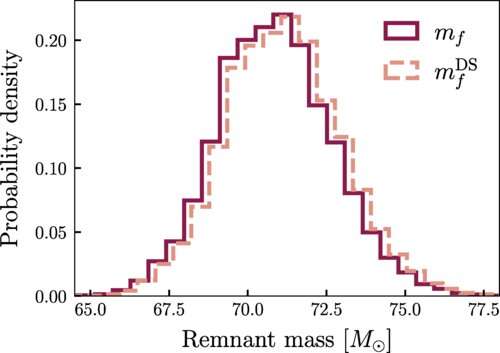The remnant mass and the Doppler shifted remnant mass for GW200129, as inferred in the detector frame. There is an overall redshift, as the kick direction in Fig. 3 is pointed (roughly) away from the observer. However, as these distributions are very close, we do not expect ringdown tests of GR to be impacted by the kick for this event. Credit: Physical Review Letters (2022). DOI: 10.1103/PhysRevLett.128.191102
A team of researchers from the Max Planck Institute for Gravitational Physics in Germany and multiple institutions in the U.S. has identified a kick velocity large enough for an individual gravitational wave event after observing a binary black hole merger—a first. In their paper published in the journal Physical Review Letters, the group describes their study of the binary black hole merger GW200129_065458 (now called GW200129) and using models to estimate its recoil velocity.
Prior research has shown that black holes emit gravitational waves. When two of them orbit each other, those gravitational waves also emit energy due to their angular momentum. This can lead to their orbits tightening until they eventually run into each other. Once they do, they merge into one large black hole with a new orbital path. Physics laws suggest that when two such bodies collide and merge, a kick can occur, where the combined gravitational waves emitted from the newly formed black hole are emitted mainly in one direction. When that happens, the black hole undergoes a recoil in the other direction, moving faster than either of its two original black holes.
In this new effort, the researchers suggest that the opposite recoil experienced by GW200129 was strong enough to have pushed the black hole past its escape velocity, ejecting it from its galaxy. Prior research has shown that some black holes travel faster than they should based on theory—they suggest that such observations are due to binary collisions resulting in opposite-recoil kicks.
A simulation of the black hole merger GW200129, showing the precession of the orbital plane and the expected gravitational signal. After merging, the final black hole is kicked in the downward direction. Credit: V. Varma/Max Planck Institute for Gravitational Physics
The researchers were the first to observe a binary merger event that showed a strong, clear signature of a change in the orientation of the rotational axis of its rotating body in its gravitational-wave data. They used that data to create theoretical simulations, calculating its kick to be approximately 1500 km/s. For comparison, the escape velocity of the Milky Way is just 550 km/s, which suggests that the kick experienced by GW200129 was strong enough to push it all of the way out of its galaxy.
More information: Vijay Varma et al, Evidence of Large Recoil Velocity from a Black Hole Merger Signal, Physical Review Letters (2022). DOI: 10.1103/PhysRevLett.128.191102
Journal information: Physical Review Letters
© 2022 Science X Network
























